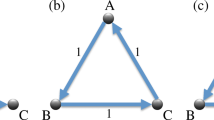Abstract
The spring-electric model is a useful tool to visualize a large-scale complex network. However, information on the flow of directed network may not be properly reflected because links are basically treated as undirected. Here, we propose a new visualization method with an explicit account of network flow structure information by combining Helmholtz–Hodge decomposition and the spring-electric model. We then demonstrate its effectiveness by adopting actual Japanese production flow network as a test ground. The Helmholtz–Hodge decomposition enables us to break down flow on a directed network into two flow components: potential flow and circular flow. The potential flow between a pair of nodes is given by difference of their potentials, and hence, the potential of a node shows its hierarchical position in a network. On the other hand, the circular flow component illuminates feedback loops built in a network. We also identify dominant clusters of firms forming feedback loops by applying a flow-based community detection method to the extracted circular flow network. We find that both hierarchical and loop structures coexist within the major industries such as construction, manufacturing, and wholesales.



Similar content being viewed by others
Notes
This is the largest connected component in the network obtained from the original data, containing 99.3% of all active firms listed in the data.
References
Allen, M. P. P. & Tildesley, D. J. (1987). Computer simulation of liquids (vol. 82, pp. 5057–5061).
Bhatia, H., Norgard, G., Pascucci, V., & Bremer, P. T. (2013). The Helmholtz–Hodge decompositiona survey. IEEE Transactions on visualization and computer graphics, 19(8), 1386–1404.
Chakraborty, A., Kichikawa, Y., Iino, T., Iyetomi, H., Inoue, H., Fujiwara, Y., & Aoyama, H. (2018). Hierarchical communities in walnut structure of Japanese production network, available at SSRN: https://ssrn.com/abstract=3129974 or https://doi.org/10.2139/ssrn.3129974.
Frenkel, D., & Smit, B. (2002). Understanding molecular simulations: from algorithms to applications. Academic press.
Fujita, Y., Fujiwara, Y., & Souma, W. (2016). Large directed-graph layout and its application to a million-firms economic network. Evolutionary and Institutional Economics Review, 13(2), 397–408.
Hu, Y. (2005). Efficient, high-quality force-directed graph drawing. Mathematica Journal, 10(1), 37–71.
Jiang, X., Lim, L. H., Yao, Y., & Ye, Y. (2011). Statistical ranking and combinatorial Hodge theory. Mathematical Programming, 127(1), 203–244.
Lancichinetti, A., & Fortunato, S. (2009). Community detection algorithms: A comparative analysis. Physical Review E, 80(5), 056117.
Rosvall, M., & Bergstrom, C. T. (2008). Maps of random walks on complex networks reveal community structure. Proceedings of the National Academy of Sciences, 105(4), 1118–1123.
Acknowledgements
This study has been conducted as a part of the project “Large-scale Simulation and Analysis of Economic Network for Macro Prudential Policy” undertaken at Research Institute of Economy, Trade and Industry (RIETI). This research was also supported by MEXT as Exploratory Challenges on Post-K computer (Studies of Multi-level Spatiotemporal Simulation of Socioeconomic Phenomena).
Author information
Authors and Affiliations
Corresponding author
Additional information
Publisher's Note
Springer Nature remains neutral with regard to jurisdictional claims in published maps and institutional affiliations.
This research was supported by MEXT as Exploratory Challenges on Post-K computer (Studies of Multi-level Spatiotemporal Simulation of Socioeconomic Phenomena, Macroeconomic Simulations). We used computational resources of the K computer provided by the RIKEN Center for Computational Science through the HPCI System Research project (Project ID:hp170242, hp180177).
Rights and permissions
About this article
Cite this article
Kichikawa, Y., Iino, T., Iyetomi, H. et al. Visualization of a directed network with focus on its hierarchy and circularity. J Comput Soc Sc 2, 15–23 (2019). https://doi.org/10.1007/s42001-019-00031-1
Received:
Accepted:
Published:
Issue Date:
DOI: https://doi.org/10.1007/s42001-019-00031-1




